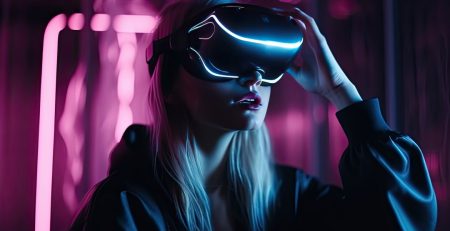Should we fear an attack of the AI clones?
In the rapidly evolving digital landscape, one technology has been making waves due to its potential for both innovation and disruption – deepfake technology. This technology uses artificial intelligence to create hyper-realistic but entirely fake content, leading to a myriad of possibilities and concerns. We are witness to the rise of deepfake technology, a phenomenon stirring a complex blend of fascination and trepidation.
The Renaissance of Content Creation:
At the frontier of deepfake technology lies the potential for a renaissance in content creation. Deepfakes promise a democratization of media production, making it accessible for creators to generate high-quality content without prohibitive costs. The implications are far-reaching and transformative: educators can bring lessons to life with historical figures, the entertainment industry can offer immersive experiences previously constrained by physical limitations, and customer service can be revolutionized through personalized virtual interactions. The potential for creating empathetic AI in healthcare to assist patients and medical professionals further underscores the positive applications of this technology.
The Promise of Deepfake Technology
Deepfake technology holds significant potential for positive use. In the film industry, it can create realistic special effects or even resurrect deceased actors for a performance. This not only enhances the viewer’s experience but also opens up new avenues for storytelling.
On one hand, deepfake technology, which uses artificial intelligence to create hyper-realistic but entirely fake content, has significant potential for positive use. For instance, it can be used in the film industry to create realistic special effects or even resurrect deceased actors for a performance. It can also be used in education, creating engaging content that brings historical figures to life or simulates experiences that would otherwise be impossible.
In education, deepfake technology can bring historical figures to life or simulate experiences that would otherwise be impossible. This can make learning more engaging and immersive, thereby enhancing the educational experience.
The Spectre of Misinformation:
With these advancements, however, comes the spectre of misinformation. The ease with which deepfakes can be propagated across social platforms raises serious concerns about their use in disinformation campaigns. Personal identities can be co-opted, leading to character assassination or privacy violations. In the political realm, deepfakes hold the ominous capability to fabricate events, potentially swaying public opinion or even destabilizing democratic institutions. The erosion of trust in media and the potential for exacerbating societal divisions are consequences that necessitate pre-emptive discussion and action.
- Film and Entertainment: Deepfake can be used to create realistic special effects, dub films in different languages using the original actor’s voice, or even resurrect deceased actors for a performance.
- Education: Deepfake can bring historical figures to life, simulate scientific phenomena, or create immersive, experiential learning environments.
- Art and Creativity: Artists can use deepfake technology to explore new forms of expression, create new types of artwork, or reimagine existing works in innovative ways.
- Medical Training: Deepfake can be used to create realistic patient scenarios for medical training, helping doctors and nurses prepare for a wide range of situations.
- Accessibility: For individuals with disabilities, deepfake technology can be used to create assistive tools, such as converting text to speech in a familiar voice, or creating sign language interpretations.
- Video Conferencing: Deepfake can be used to improve the quality of video conferencing, by enhancing video clarity, modifying the background, or translating speech in real-time.
- Advertising: Advertisers can use deepfake to tailor their content to different audiences, or to create personalized advertisements featuring a customer’s favourite celebrity.
- Journalism: News outlets can use deepfake technology to recreate events or scenarios, helping viewers to better understand the context of a news story.
The Perils of Deepfake Technology
However, the same technology also has a darker side. Deepfakes can be used to create misleading content, spreading disinformation or damaging reputations. They can be used to impersonate individuals, potentially leading to fraud or identity theft. Moreover, as the technology becomes more accessible, the risk of misuse increases.
However, the same technology also has a darker side. Deepfakes can be used to create misleading content, spreading disinformation or damaging reputations. They can be used to impersonate individuals, potentially leading to fraud or identity theft. Moreover, as the technology becomes more accessible, the risk of misuse increases.
- Disinformation: Deepfakes can be used to create fake news and propaganda, potentially influencing public opinion and disrupting democratic processes.
- Fraud: By impersonating individuals, deepfakes can be used to commit fraud, such as creating fake endorsements or fraudulent financial transactions.
- Cybersecurity Threats: Deepfakes can be used in phishing attacks, where an attacker impersonates a trusted individual to trick victims into revealing sensitive information.
- Reputation Damage: Deepfakes can be used to create false and damaging content about individuals, potentially harming their reputation and causing emotional distress.
- Legal Challenges: Deepfakes can complicate the legal landscape, making it difficult to distinguish between real and fake evidence in court cases.
- Identity Theft: Deepfakes can be used to impersonate individuals, leading to potential identity theft and privacy violations.
- Political Manipulation: Deepfakes can be used to create fake speeches or actions by politicians, potentially influencing elections and political discourse.
- Social Disruption: By creating realistic but false content, deepfakes can sow discord and confusion in society, undermining trust in media and institutions.
- Blackmail and Extortion: Deepfakes can be used to create compromising or damaging content about an individual, even if the events depicted never occurred. This fabricated content could then be used for blackmail or extortion purposes. For instance, a deepfake video could be created to show a person in a compromising situation, and then used to demand money or other favors under the threat of releasing the video to the public. This not only poses a serious threat to the individual’s privacy and reputation, but also presents a legal challenge in terms of proving the content is indeed a deepfake.
- Public Panic and Fear: Deepfakes can be used to create realistic emergency scenarios that never happened. For instance, a deepfake video could be created to show a natural disaster, a violent event, or a public health emergency in a certain location. If this video is shared widely on social media, it could cause unnecessary panic and fear among the public. This could lead to chaos, disrupt public services, and even put lives at risk.
Navigating the Deepfake Landscape
So, should we fear an attack of the AI clones? The answer is not straightforward. While there are legitimate concerns about the misuse of deepfake technology, it’s important to remember that like any tool, its impact depends on how it’s used. As leaders, our role is to understand this technology, its potential benefits and risks, and to guide its development and use in a way that benefits society as a whole.
Navigating the Ethical Labyrinth:
The conundrum of deepfake technology lies not within the code and algorithms that compose its fabric but within the ethical labyrinth it presents. Regulation must evolve in tandem with technological progress, ensuring that there are clear boundaries and repercussions for malicious use. The onus is also on the creators and disseminators of AI to cultivate ethical standards that govern the deployment of deepfakes. Transparency in content creation, coupled with the advancement of detection technologies, can provide a bulwark against the misapplication of deepfakes.
Leadership in the Age of AI Clones:
For business leaders and CEOs, the advent of deepfake technology necessitates a vigilant and informed approach. As custodians of brand integrity and trust, leaders must institute robust security frameworks to protect against the exploitation of deepfake technology. Fostering an organizational ethos that prioritizes ethical use of AI, and investing in education that promotes digital literacy, are vital steps in leveraging the benefits of deepfakes while mitigating risks.
The Way Forward:
The trajectory of deepfake technology is not set in stone; it is a path that we can navigate with prudence and foresight. By embracing a multifaceted approach that includes proactive regulation, technological countermeasures, and a commitment to ethical use, we can tilt the scales towards the vast potential of deepfakes as a force for good. It is incumbent upon us to foster a digital ecosystem where innovation thrives, but not at the cost of truth and trust.
Conclusion: In the final analysis, an ‘attack of the AI clones’ should not be viewed as an inevitable dystopian future but rather as a call to action for responsible stewardship of technology. As we advance into the AI frontier, let us arm ourselves with knowledge, equip our institutions with the tools for integrity, and guide our societies towards a future where technology serves as a bridge to greater human understanding and creativity, not as a chasm that divides us.
Conclusion
In conclusion, while deepfake technology presents certain risks, it also offers exciting possibilities. The key is to approach it with a balanced perspective, promoting its positive use while putting in place measures to prevent misuse. This way, we can harness the power of AI without fearing an attack of the clones. By fostering a culture of responsible use and ethical guidelines, we can ensure that deepfake technology is used for the benefit of all, rather than to the detriment of some.
Check out my previous blogs at – Rethink AI Risk before it kills Your Business – Kieran Gilmurray









Leave a Reply